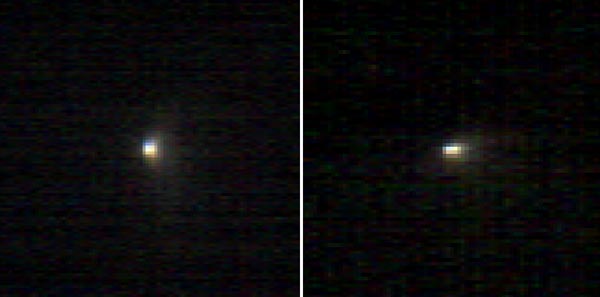Image From Mars-Orbiting Spectrometer Shows Comet’s Coma

These two infrared images of comet C/2013 A1 Siding Spring were taken by the Compact Reconnaissance Imaging Spectrometer for Mars (CRISM) aboard NASA's Mars Reconnaissance Orbiter on Oct. 19, 2014. NASA/JHUAPL
Comet Siding Spring – an Oort Cloud comet that may contain material from the formation of the solar system some 4.6 billion years ago – was making its first voyage through the inner solar system. CRISM and many other instruments and spacecraft combined to provide an unprecedented data set for an Oort Cloud comet.
CRISM acquired the first image at 2:16 pm EDT on Oct. 19, just prior to the comet's closest approach to Mars at 2:27 pm EDT, when it came within roughly 88,000 miles of the planet. The second image was taken 37 minutes later, during which the comet – traveling at approximately 34 miles per second – had traversed one-third of the way across the Martian sky.
The scale of the left image is approximately 4 kilometers per pixel; for the right image, it is about 5 kilometers per pixel. The images, which have had brightness and color enhancements, provide very different perspectives on this intriguing comet.
The images show the inner part of the cloud of dust, called the coma, that is generated around the nucleus by the warmth of the sun. The solid nucleus itself is not resolved. CRISM observed 107 different wavelengths of light in each pixel. Here, only three colors are shown.
Researchers think the appearance of color variations in the inner coma could be due to the properties of the comet's dust, possibly dust grain size or composition. The full spectra will be analyzed to better understand the reason for the color variations.
CRISM is one of six instruments on NASA's Mars Reconnaissance Orbiter. The Johns Hopkins University Applied Physics Laboratory in Laurel, Maryland provided and operates CRISM; Lockheed Martin Space Systems in Denver built the orbiter.
NASA's Jet Propulsion Laboratory in Pasadena, California manages MRO for NASA's Science Mission Directorate, Washington, D.C. For more information about NASA Mars missions, visit: www.nasa.gov/mars
The Applied Physics Laboratory, a not-for-profit division of The Johns Hopkins University, meets critical national challenges through the innovative application of science and technology. For more information, visit www.jhuapl.edu
Media Contact
All latest news from the category: Physics and Astronomy
This area deals with the fundamental laws and building blocks of nature and how they interact, the properties and the behavior of matter, and research into space and time and their structures.
innovations-report provides in-depth reports and articles on subjects such as astrophysics, laser technologies, nuclear, quantum, particle and solid-state physics, nanotechnologies, planetary research and findings (Mars, Venus) and developments related to the Hubble Telescope.
Newest articles

Superradiant atoms could push the boundaries of how precisely time can be measured
Superradiant atoms can help us measure time more precisely than ever. In a new study, researchers from the University of Copenhagen present a new method for measuring the time interval,…

Ion thermoelectric conversion devices for near room temperature
The electrode sheet of the thermoelectric device consists of ionic hydrogel, which is sandwiched between the electrodes to form, and the Prussian blue on the electrode undergoes a redox reaction…

Zap Energy achieves 37-million-degree temperatures in a compact device
New publication reports record electron temperatures for a small-scale, sheared-flow-stabilized Z-pinch fusion device. In the nine decades since humans first produced fusion reactions, only a few fusion technologies have demonstrated…





















